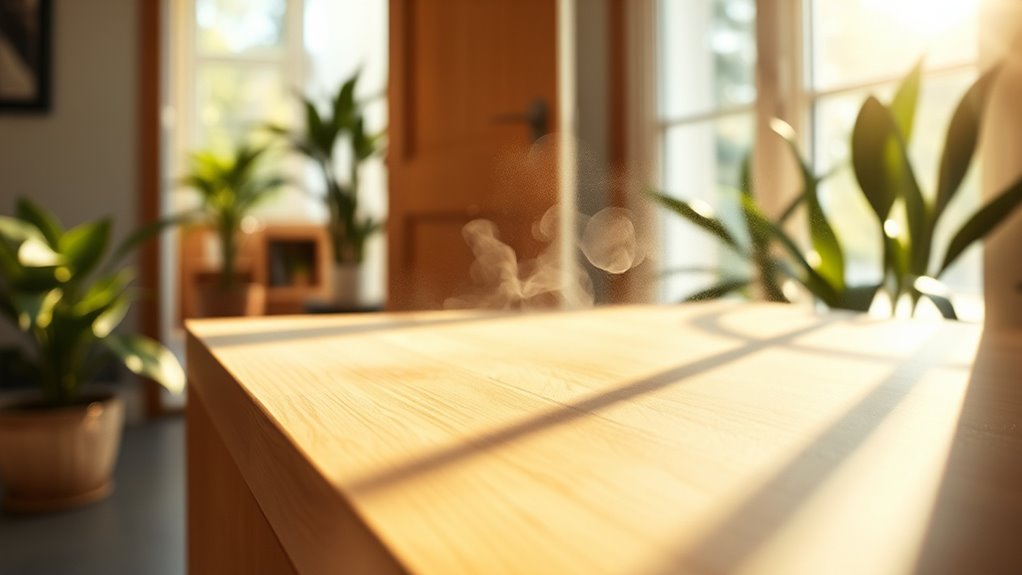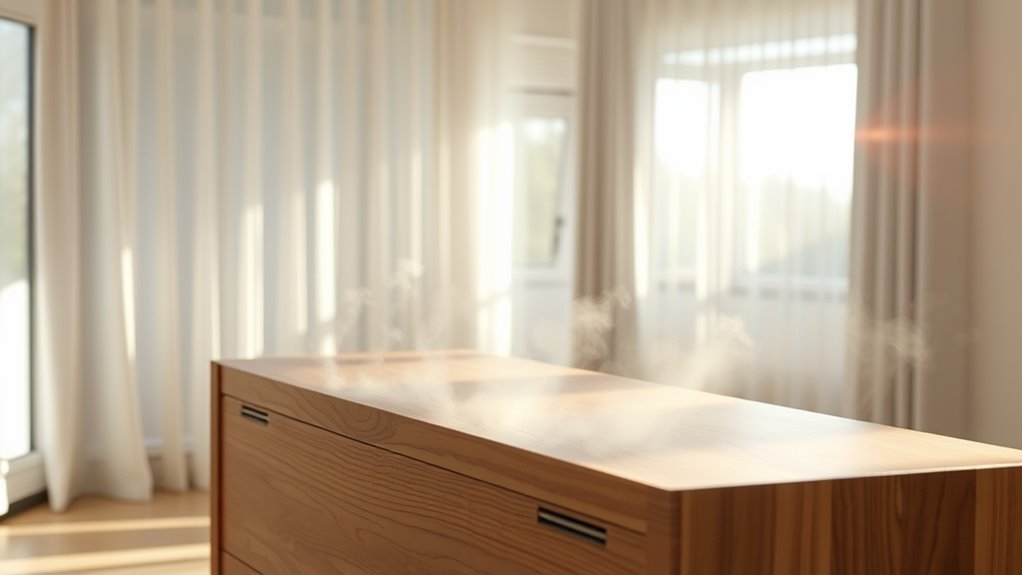Off-gassing happens when new furniture, carpets, or household products release volatile organic compounds (VOCs) into your indoor air, which can cause health issues over time. You can speed up this process by ventilating your space, opening windows, and using fans to circulate fresh air. Placing items outdoors or in a well-ventilated area before bringing them inside also helps. Keep exploring to discover more practical ways to minimize off-gassing and improve your indoor air quality.
Key Takeaways
- Off-gassing is the release of VOCs from new furniture or products into indoor air.
- Pre-ventilate items outside or in a well-ventilated area before bringing them indoors.
- Increase indoor airflow with open windows and fans to help speed up VOC dissipation.
- Use air purifiers with activated carbon filters to absorb and reduce VOC levels indoors.
- Choosing low-emission or certified products minimizes initial off-gassing and promotes healthier indoor air.

When new furniture, carpets, or household products are introduced into your home, they often release volatile organic compounds (VOCs) in a process called off-gassing. These emissions can cause health issues, especially in the first few days or weeks after bringing new items inside. To manage this, focusing on VOC reduction is essential. You want to minimize the amount of harmful chemicals in your indoor environment to protect your health. One effective way to do this is by guaranteeing material safety—choosing products made with low-emission materials or those certified for indoor air quality standards.
Start by thoroughly inspecting product labels before purchasing. Look for certifications like GREENGUARD or EPA’s Safer Choice, which indicate that the items meet strict VOC emission limits. When possible, opt for furniture and household items made from natural or sustainably sourced materials. For example, solid wood furniture generally emits fewer VOCs than pressed wood or particleboard, which often contain adhesives and resins that release chemicals over time. Once in your home, take steps to enhance VOC reduction by allowing new items to off-gas outside or in a well-ventilated space before bringing them inside. This pre-ventilation helps to considerably lower the initial VOC levels.
Inspect labels for GREENGUARD or Safer Choice certifications and prefer natural, sustainably sourced materials to reduce VOC emissions.
Once inside, keep the windows open and use fans to circulate fresh air, accelerating the off-gassing process. Air purifiers equipped with activated carbon filters can also help absorb VOCs, contributing to your overall VOC reduction strategy. Remember, the goal is to improve material safety—not just for immediate comfort, but for long-term health. Regularly cleaning surfaces and fabrics can also reduce accumulated VOCs and other airborne pollutants. If you’re concerned about specific products, consider testing your indoor air quality with a VOC monitor, which provides real-time data and helps you identify sources that need further mitigation.
Incorporating these practices into your routine ensures you’re actively working toward a healthier home environment. Prioritizing material safety means choosing products designed to emit fewer toxins and taking proactive steps to ventilate and purify your space. This approach doesn’t just speed up the off-gassing process; it creates a safer, more comfortable living environment for you and your family. Ultimately, understanding the importance of VOC reduction and material safety empowers you to make smarter choices when it comes to household products, ensuring your home remains a safe and healthy haven.
Frequently Asked Questions
How Long Does Off-Gassing Typically Last for Different Materials?
You might wonder how long off-gassing lasts for different materials. Typically, it depends on material longevity and VOC emission rates, with new items like furniture or paint emitting higher VOCs initially. Usually, off-gassing diminishes markedly within a few weeks to months, but some materials may emit VOCs for years. To speed up the process, increase ventilation and choose low-VOC products, reducing exposure sooner.
Are There Health Risks Associated With Off-Gassing Indoors?
Sure, breathing indoor air filled with VOCs sounds like a fun experiment, right? Actually, yes, there are health risks—like headaches, dizziness, or long-term issues—that come with poor indoor air quality. To protect yourself, focus on VOC reduction by ventilating well and choosing low-emission materials. So, while off-gassing might seem harmless, it’s best to stay vigilant and keep your indoor air quality in check.
Can Certain Cleaning Products Reduce Off-Gassing?
You can reduce off-gassing by using cleaning products with low VOC levels, which helps minimize the release of harmful chemicals. Additionally, air purifiers with activated carbon filters can markedly improve indoor air quality by absorbing VOCs. Regularly ventilate your space and choose eco-friendly cleaning supplies to speed up VOC reduction. These steps create a safer environment and lessen the health risks associated with indoor off-gassing.
Does Temperature Influence the Off-Gassing Process?
You might notice that temperature effects on materials often seem coincidental, but they really influence off-gassing. When temperatures rise, materials tend to become less stable, accelerating off-gassing. Conversely, cooler temperatures help maintain material stability, slowing the process. So, by controlling the temperature in your environment, you can effectively speed up or slow down off-gassing, making your space safer and more comfortable.
Are There Specific Brands Known for Low or No Off-Gassing Products?
You should look for brands with a strong reputation for safety and eco-friendliness. Brands like Avocado, Tuft & Needle, and Naturepedic are known for low or no off-gassing products. Check their product certifications, like GREENGUARD or CertiPUR-US, which guarantee minimal chemical emissions. By choosing certified brands, you can confidently reduce your exposure to off-gassing chemicals and promote a healthier indoor environment.
Conclusion
Understanding off-gassing helps you recognize the signs, take action, and create a healthier space. By ventilating, cleaning, and choosing low-emission products, you actively reduce harmful fumes, speed up the process, and improve your environment. Remember, patience and proactive steps go hand in hand—ventilate to refresh, clean to clear, and choose wisely to prevent. Embrace these actions, accelerate the off-gassing process, and breathe easier, knowing you’re making a positive difference for yourself and your space.









